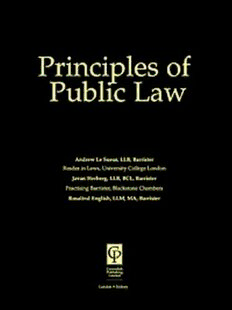
Principles of Public Law PDF
635 Pages·1999·1.592 MB·English
Most books are stored in the elastic cloud where traffic is expensive. For this reason, we have a limit on daily download.
Preview Principles of Public Law
Description:
To understand what the modern constitution is, it is necessary to examine what it does - putting into practice the goals of liberal democracy. The first part of this book looks at history, contemporary politicians and textbook writers for what they reveal about these aims. In the second part, the book considers the status of some of the main institutions of the constitution: the United Kingdom Parliament, the institutions of the European Union and the many different forms of public authorities through which people are governed. The third part examines how the constitution seeks to resolve disputes between people and public authorities - including analyses of ombudsmen, judicial review and European Community law. In the final part, civil liberties and human rights are examined. Having explained the significance of the Human Rights Act 1998 and the European Court of Human Rights, the chapters here evaluate the legal protection of several different rights, including the right to life, liberty of the person, non-retrospectivity of law, privacy, freedoms of expression, assembly and association, equality and free movement.
See more
The list of books you might like
Most books are stored in the elastic cloud where traffic is expensive. For this reason, we have a limit on daily download.
